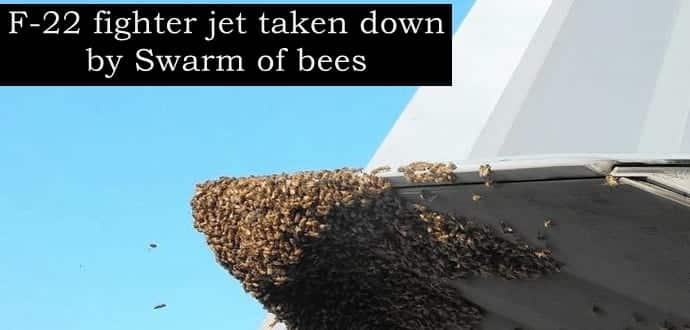Nature’s fury : 20,000 honeybees ground F-22 fighter jet
A man can fly, go undersea or orbit the Earth but he still doesnt have answers to natures fury. This ways displayed in its true form when a massive hive of honeybees forced the U.S. Air Force to ground an F-22 Raptor at Joint Base Langley-Eustis that had engulfed part of the aircraft.
According to a recent U.S. Air Force press release, “192nd Fighter Wing Aircraft Maintainers were bemused when they found a swarm of honey bees hanging from the exhaust nozzle of an F-22 Raptor engine following flight operations at Joint Base Langley-Eustis, Virginia.”
Everyone was shocked to see the swarm of tens of thousands of honeybees blocked the jet’s exhaust at one air base in Virginia probably left their overcrowded hive in search of a new niche.
The airmen’s initial reaction was to run away and find someone to “get rid of the bees,” the squadron reported on its Facebook page.
“I was shocked like everyone else because it looked like a cloud of thousands of bees,” said Tech Sergeant Jeffrey Baskin, a maintenance crew chief, “but I knew they wouldn’t sting anyone and were just looking for a new place to live. My neighbour maintains two colonies of honey bees and I knew they were at risk for extinction, I figured we might want to get a honey bee expert out to collect them.”
After informing different officials, an on-base entomologist was called to evaluate the situation who referred officials to a local honey bee keeper in Hampton.
U.S. Navy retired and local bee keeper Andy Westrich arrived on base with materials and supplies to transport the bees.
Westrich said that the swarm was one of the largest he had ever seen. He was accompanied to the aircraft and used vacuum hoses to safely cage the honey bees off of the aircraft into large buckets. He then took the bees home and found that they weighed eight pounds as a hive, which calculates to almost 20,000 bees.
“The honey bees most likely came from a much larger bee hive somewhere else on base,” said Chief Master Sergeant Gregg Allen, 192nd Maintenance Group Quality Assurance chief, who also happens to be a bee keeper. “Bee hives are constantly growing and they eventually become overcrowded. Around springtime, the bees will make a new queen, scout for a new location and take half of the hive with them to that location.”
Westrich had reason to believe the swarm were on their way to a new location to build a hive for their queen. Queen bees typically fly with eggs to lay at the new hive probably landed on the jet to rest, as bees go without food for up to 10 days when they are relocating to build a new hive. Honeybees do not leave the queen, so they swarmed around the F-22 and eventually landed there.
Westrich was successfully able to safely relocate the colony to a local beer producer where they will be maintained and the honey they produce used to make beer.
“Every bee is important to our food source; lots of things would die without bees,” said Baskin. “Most of our crops depend on bees, and our bees need to pollinate. This is why I knew we needed to save them instead of [exterminate] them.”

